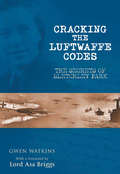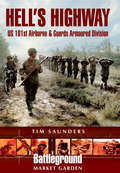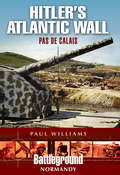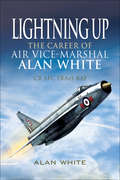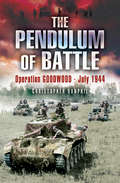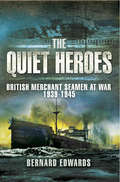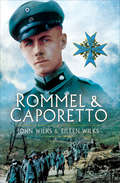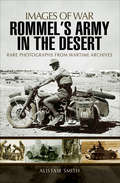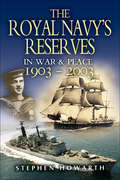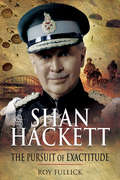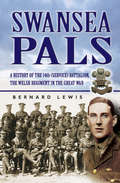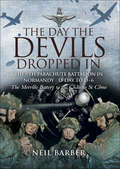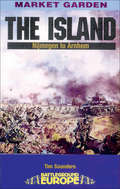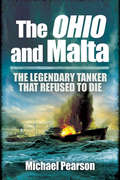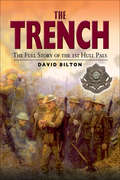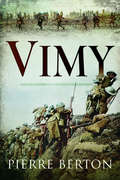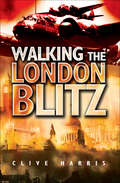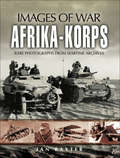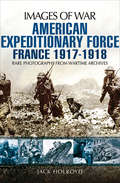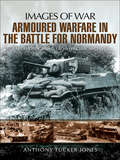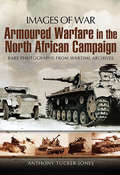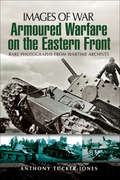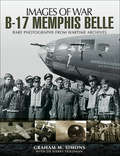- Table View
- List View
Cracking the Luftwaffe Codes: The Secrets of Bletchley Park
by Gwen WatkinsAn intriguing page-turning and personal account of that most secretive of wartime institutions, Bletchley Park, and of the often eccentric people who helped to win the war Beryl BainbridgeBletchley Park, or 'Station X', was home to the most famous code breakers of the Second World War. The 19th-century mansion was the key center for cracking German, Italian and Japanese codes, providing the allies with vital information. After the war, many intercepts, traffic-slips and paperwork were burned (allegedly at Churchill's behest). The truth about Bletchley was not revealed until F. Winterbotham's The Ultra Secret was published in 1974. However, nothing until now has been written on the German Air Section. In Cracking the Luftwaffe Codes, former WAAF (Women's Auxiliary Air Force) Gwen Watkins brings to life the reality of this crucial division. In a highly informative, lyrical account, she details her eventful interview, eventual appointment at the 'the biggest lunatic asylum in Britain', methods for cracking codes, the day-to-day routine and decommissioning of her section.
Hell's Highway: U.S. 101st Airborne & Guards Armoured Division (Battleground Market Garden)
by Tim SaundersThis WWII history and battleground guide offers a fascinating look at the vital and infamous stretch of road through the Netherlands. After the Allied victory at Normandy, Operation Market Garden was intended to cut a path to Germany through the Netherlands. Essential to the plan was a two-lane road that came to be known as Hell's Highway. This was the route that the British 3rd Guards Armored Division had to advance down rapidly to relieve the American Paratroopers of the 82d Airborne at Nijmegen and the British I st Airborne Division at Arnhem. Beginning with the famous capture of Joe&’s Bridge by the Irish Guards—an essential preliminary action before the start of Operation Market Garden—historian Tim Saunders guides visitors through the seizure of bridges, the liberation of small towns, and other actions undertaken by the famous Screaming Eagles. With vivid personal accounts throughout, this guide features practical visitor information about monuments and other important sites.
Hitler's Atlantic Wall: Pas de Calais (Battleground Normandy)
by Paul WilliamsThis well-illustrated book describes the massive effort that the occupying Nazi forces put into the construction of the Eastern section of the Atlantic Wall. While the D-Day invasion was unaffected by the fortifications in this area, they still posed a significant threat. This came from the mighty gun batteries (such as Batteries Todt and Lindemann) that threatened Channel shipping and the South Coast of England, and, while isolated from the main Allied advance, the Festung ports of Calais, Boulogne and Dunkirk were denied to Allied use. This was of major strategic significance as the lines of supply were becoming ever longer and more vulnerable.Using rare archive material, this book takes the reader on a fascinating journey along the coast that Hitler was wrongly convinced would be the site of the Allied landings. Hitlers Atlantic Wall Pas de Calais tells the history of how and why the giant batteries were built, the origins of their weaponry and the ingenious engineering and military operations that defeated them finally.
Lightning Up: The Career of Air Vice-Marshal Alan White CB AFC FRAeS RAF
by Alan WhiteAlan White served in the RAF from 1953 to 1987 roughly the period of the Cold War. His introduction to flying came in his University Air Squadron. This seduced him into dropping out of University and joining the RAF. He initially had success during the piston-engine stages of his training but damage to a Vampire T11 and a bad start on the Hunter Weaponry Course set his confidence back until he recovered during service with his first Hunter Squadron. The infamous Duncan Sandys' cuts of 1957 caused the closure of his squadron and he found himself towing air-to-air gunnery targets, but luckily he was then moved to instruct on the Hunter Operational Conversion Unit where he developed his solo aerobatic display skills. He was then posted to take Hunters to Singapore and form a Squadron. He became involved with the SEATO response to assist the Thai governments request against communist insurgents from Laos and spent five months at Chiang Mai camping in a paddy field. After attending Staff College he was posted to Aden at a time of growing terrorist activity. He worked with the C-in-C, Admiral Sir Michael Le Fanu. Upon his return to the UK he trained to fly the supersonic Lightning fighter and eventually was promoted to lead a squadron. There followed a period of rapid promotion and he became Station Commander at RAF Leuchars. His later appointments as Air Commodore included Director of Operations (Air Defence), Senior Staff Officer HQ 11 Group, Air Commodore Plans at HQ Strike Command (where he assisted in the Falklands conflict) until he was promoted to his final rank and appointed Deputy Commander RAF Germany and then finally he became Commandant, RAF Staff College. His account is full of interesting flying detail and the internal workings of the RAF during those dangerous Cold War days.
The Pendulum of Battle: Operation Goodwood, July 1944
by Christopher DunphieAn account of the World War II clash between British and German forces, &“the largest tank battle involving British armor ever fought&” (MQ Magazine). Operation Goodwood, the largest tank battle involving British troops ever to have taken place, has been a perpetual subject of controversy. Was it intended as a breakout from the Normandy Bridgehead, or not? Was it a success or failure? Did it lead to a severe crisis in confidence over Field Marshal Montgomery&’s leadership? This book seeks to unearth the true background, reasons, aims and achievement of Goodwood, set in the context of the overall campaign, while bringing the battle to life through personal accounts of some of those involved, both British and German.&“This well-informed account provides an excellent balance between the strategy and tactics . . . Even in a year which is seeing an unprecedented number of books on the Second World War, Pendulum of Battle deserves to be read. It is a serious, yet highly readable study of warfare and can be warmly recommended.&” —MQ Magazine
Quiet Heroes: British Merchant Seamen at War, 1939–1945
by Bernard EdwardsThe men of Britain's Merchant Navy, although unarmed civilians going about their lawful business were the first to be involved with the enemy in the Second World War. Less than nine hours after the declaration of war on 3 September 1939, the Donaldson liner Athenia was sunk without warning by a German U-boat off the west coast of Ireland. From that moment onwards, British merchant seamen were constantly in the front line in all quarters of the globe. For almost six years they faced, without flinching, their own private hell of torpedoes, bombs, shells and mines, all the while fending off their old arch-enemy, the sea. Sorely pressed, and often tired near to death, they kept open Britain's tenuous lifelines, bringing millions of tons of raw materials, food, oil, arms and ammunition, without which the country could not have survived. As always, their spirit was indomitable, their professionalism unchallenged. The price they paid for their bravery and dedication was horrendous: 2,246 ships lost, 29,180 men killed, and countless hundreds maimed and wounded. This book tells the story of just a few of these quiet heroes.
Rommel and Caporetto (Images Of War Ser.)
by Eileen Wilks John WilksRommel was to become the most respected of all generals in World War Two but no-one outside of a small clique in the German Army had heard of him in 1917. His role at the Battle of Caporetto in 1917 where the Italian Army was humiliated at a catastrophic defeat has received little attention yet it was the springboard for his future success. This makes for a fascinating and important story. The book, by the authors of The British Army in Italy 1917–1918, is based largely on official histories and documents, and on Rommels own account, which gives some insight into the qualities that he was later to exhibit in France and in North Africa.
Rommel's Army in the Desert: Rare Photographs from Wartime Archives (Images of War)
by Alistair SmithWhen German General Rommel and the lead elements of what would become the Afrika Korps landed in Libya in February 1941, nobody could have foreseen the legendary status they would achieve. Sent to support the faltering Italians, they were eventually able to drive the Allies to the very gates of Egypt. Fighting over hostile and rugged terrain, often outnumbered and outgunned, they were only finally undone by their defeat at El Alamein and Allied landings to their rear.This collection of photographs is taken from the albums of three members of the vaunted Afrika Korps. For the first time the daily reality of the North African campaign can be seen from the German point of view. With numerous photographs of vehicles and men at work, this collection paints a portrait of the rugged and dangerous conditions as well as the harsh and brutal nature of desert warfare.
Royal Navy's Reserves in War and Peace, 1903–2003
by Stephen HowarthThe official volume marking the centenary of the Royal Naval Volunteer Reserve, known as the 'Wavy Navy' because of the distinctive wavy gold stripes on the reservists' uniforms, from its formation in 1903 through its unification with the mercantile Royal Reserve in 1958, and on to its present complete integration with the Royal Navy as 'the part-time element of a single naval service'.It charts the difficulties, setbacks and delights of the reservists' peacetime years of service and chronicles their vital contributions during wartime.Since the end of the Cold War and the dramatic near-dissolution of the RNR in 1994, members of the modernized part-time volunteer service have served in many different RN operations at sea, on land and in the air, from the Balkans to the Gulf.This detailed and vivid history which and profusely illustrated is by a distinguished writer of naval history who served in the modern RNR both as a rating and an officer for over eleven years.
Shan Hackett: The Biography of Sir General John Hackett GCB DSO MC
by Roy Fullick'Shan' Hackett is remembered by his own and succeeding generations for a variety of achievements and attributes. A superb fighting soldier, he served with the Trans-Jordan Force, had fought through North Africa and was involved in the formation of the Long Range Desert Group, the SAS and Popski's Private Army. He went on to raise 4th Parachute Brigade which he commanded with flair at Arnhem where he was wounded and captured. He escaped and got back to British lines. He rose to high rank filling key command and staff appointments in the British Army and NATO.Always an intellectual, yet highly practical man, he retired to become Principal of King's College London where he was revered by staff and students. He wrote many acclaimed works including The Third World War and its sequel The Third World War - The Untold Story. He was constantly in demand in Britain for his television programs and radio commentary up to his death in 1997
Swansea Pals: A History Of 14th (service) Battalion, Welsh Regiment In The Great War
by Bernard LewisThe Swansea Battalion was formed from local men by the Mayor of Swansea in the response to Lord Kitcheners famous appeal for volunteers. This, the first full history of the Battalion, covers early recruiting for the battalion in the Swansea area and its subsequent training in Swansea, Rhyl and Winchester, prior to departure, some 1,200 strong, in December 1915 for the Western Front. As part of the 38th Welsh Division it participated in the attack on Mametz Wood on the Somme where, in a single day, it suffered almost 100 men killed and 300 wounded out of an attacking contingent of less than 700. A further very successful raid on the German held High Command Redoubt was followed by front line service in the dreaded Ypres Salient. Here it took part in the bloody third Battle of Ypres, better known today as the Passchendaele Offensive. At Aveluy Wood it was accidentally shelled by its own artillery, suffering a number of fatalities. The Swansea Battalion then took an active part in the battles that finally broke the Hindenburg Line and the spirit of German resistance, one of its exploits being described as the high point of soldierly achievement by Douglas Haig. It was still advancing when the Armistice was signed in November 1918.
The Day the Devils Dropped In: The 9th Parachute Battalion in Normandy - D-Day to D+6: The Merville Battery to the Château St Côme
by Neil BarberThis WWII history presents a vivid chronicle of the British Army&’s 9th Parachute Battalion and their operations in Normandy based on survivor interviews. The first hours and days following the Allied invasion of Normandy were perhaps the most crucial moment of the Second World War. The Day The Devils Dropped In examines the pivotal role played by the 9th Battalion of the Parachute Regiment in the first week of the landings. These brave British soldiers were tasked with neutralizing the mighty Merville Battery, and capturing Le Plein and the Chateau St. Côme on the Breville Ridge. Failure by to achieve any of these objectives could have meant disaster for Operation Overlord—and catastrophe for the Allied war effort. In his quest to uncover what transpired in the early days of the landings, historian Neil Barber tracked down and interviewed surviving participants in the operation. In The Day the Devils Dropped In, he presents the full story, largely in the very words of those who lived through the experience. Enhanced by wartime photographs throughout, this revealing chronicle is a fine tribute to those whose contribution must never be forgotten.
The Island: Nijmegen to Arnhem (Battleground Europe)
by Tim SaundersHaving fought their way up fifty miles of Hell's Highway and through Nijmegen, XXX Corps was just ten miles from Arnhem and the 1st British Airborne Division. Here it found itself on an island of flat land between the Waal at Nijmegen and the Rhine at Arnhem. The situation was increasingly bad with the remainder of II SS Panzer Corps in the area and German counter attacks on Hell's Highway preventing the Allies applying their material superiority. The Guards Armoured and then 43rd Wessex Infantry Division took turns to lead before reaching the Rhine opposite the paratroopers in the Oosterbeek Perimeter. Attempts to cross the Rhine by the Polish Paras and the Dorset Regiment had little success, but meanwhile, the guns of XXX Corps ensured the survival of the Perimeter. After some desperate fighting on the island, 43rd Wessex Division evacuated just two thousand members of the elite Airborne Division who had landed eight days earlier.
The Ohio and Malta: The Legendary Tanker That Refused to Die
by Michael PearsonDuring the dark days of World War 2, Malta became the lynchpin of the Allied campaign in the Mediterranean and North African theaters and a vital base from which to attack Axis convoys supplying Rommel's Panzer Armee in Libya. Malta was, however, extremely difficult to keep supplied, (particularly with oil), and by the summer of 1942 the Island was close to surrender; the Pedestal convoy of August that year was literally the last chance.On entering the Mediterranean, the convoy was subjected to prolonged ferocious air and submarine attacks and suffered terrific losses both in warship escorts and merchant men. OHIO, being the only tanker, was marked for particular attention, and during the course of her voyage suffered a direct hit from a torpedo, direct bomb hits, any number of near-misses, and was struck by two Luftwaffe aircraft shot down while attacking her. Despite her engines being dead and her hull practically broken in two, she was towed into Grand Harbor by three destroyers and a minesweeper with her vital cargo virtually intact.
The Trench: The True Story of the Hull Pals
by David BiltonThe book details the history of the 10th Battalion of the East Yorkshire, known as the Hull Pals, from September 1914 to May 1918. In around 150 pages it will provide viewers with answers to the questions the program will generate: Who were these men? What did they do? Which of them survived? Where did they really come from? Did they really live like this? Over 150 photographs, illustrations and maps record in detail the lives of these men; many of the illustrations have never been seen before.Known locally as "The Commercials" because they were a battalion of office workers, the 1400 men trained in England, were sent to fight the Turks in Egypt and then returned to spend nearly three years in the trenches of the Western Front. Their losses were heavy, with around one in four being killed.
Vimy
by Pierre BertonThe bestselling, award-winning author of The American Invasion of Canada &“has given great drama and immediacy to that turning point in Canadian history&” (Maclean&’s). On Easter Monday 1917 with a blizzard blowing in their faces, the four divisions of the Canadian Corps in France seized and held the best-defended German bastion on the Western Front—the muddy scarp of Vimy Ridge. The British had failed to take the Ridge, and so had the French who had lost 150,000 men in the attempt. Yet these magnificent colonial troops did so in a morning at the cost of only 10,000 casualties. The author recounts this remarkable feat of arms with both pace and style. He has gathered many personal accounts from soldiers who fought at Vimy. He describes the commanders and the men, the organization and the training, and above all notes the thorough preparation for the attack from which the British General Staff could have learned much. The action is placed within the context both of the Battle of Arras, of which this attack was part, and as a milestone in the development of Canada as a nation.&“This wonderful book brings to life the amazing men who came across the Atlantic nearly a century ago and won a famous victory which helped change a nation forever . . . the wonderful prose of Pierre Berton is all from the heart and you should share in it.&” —War History Online&“The cinematic writing plunks the reader in the midst of the actual battle, and a judicious use of quotes from soldiers&’ diaries and letters helps provide a ground-level perspective.&” —Quill & Quire
Walking the London Blitz: Five Walks Revisiting The Blitz (Battleground Europe Ser.)
by Clive HarrisA unique way to experience the history of London during the Blitz of World War II through seven leisurely and informative walks. In Walking the London Blitz, Clive Harris guides you on a highly informative tour through one of World War II&’s most pivotal and devastating military campaigns. By means of seven easily manageable walks and accompanying maps and photographs, anyone—from history buffs to tourists to seasoned armchair travelers—can experience the significant sites of those dark days when the German Luftwaffe relentlessly bombed Great Britain between 1940 and 1941. Some of the walking tours include: Bank Station to London Bridge Station; Ludgate Circus to Trafalgar Square; Marble Arch to the Cabinet War Rooms; Hyde Park Corner to Westminster; and London Bridge to St. Paul&’s. Using rich anecdotes and first-hand accounts, the suffering and bravery of ordinary Britons in the face of Hitler&’s V-weapon attacks comes to life.
Walking the London Blitz: Five Walks Revisiting The Blitz (Battleground Europe Ser.)
by Clive HarrisA unique way to experience the history of London during the Blitz of World War II through seven leisurely and informative walks. In Walking the London Blitz, Clive Harris guides you on a highly informative tour through one of World War II&’s most pivotal and devastating military campaigns. By means of seven easily manageable walks and accompanying maps and photographs, anyone—from history buffs to tourists to seasoned armchair travelers—can experience the significant sites of those dark days when the German Luftwaffe relentlessly bombed Great Britain between 1940 and 1941. Some of the walking tours include: Bank Station to London Bridge Station; Ludgate Circus to Trafalgar Square; Marble Arch to the Cabinet War Rooms; Hyde Park Corner to Westminster; and London Bridge to St. Paul&’s. Using rich anecdotes and first-hand accounts, the suffering and bravery of ordinary Britons in the face of Hitler&’s V-weapon attacks comes to life.
Afrika-Korps: Rare Photographs from Wartime Archives (Images of War)
by Ian BaxterA pictorial history of the Nazi German army expeditionary force deployed to North Africa during World War II between 1941 and 1943.Afrika-Korps is an illustrated record of Field-Marshal Erwin Rommel and his desert troops that fought in North Africa against British and Commonwealth forces between 1941 and 1943. Using previously rare and unpublished photographs, many of which have come from the albums of individuals who took part in the desert campaign, it presents a unique visual account of the famous Afrika-Korps operations and equipment. Thanks to an informative caption with every photograph Afrika Korps vividly portrays how the German Army fought across the uncharted and forbidding desert wilderness of North Africa. Throughout the book it examines how Rommel and his Afrika Korps were so successful and includes an analysis of desert war tactics which Rommel himself had indoctrinated. These tactics quickly won the Afrika-Korps a string of victories between 1941 and 1942. The photographs that accompany the book are a fascinating collection that depicts life in the Afrika-Korps, as seen through the lens of the ordinary soldier.
American Expeditionary Force: France, 1917–1918 (Images of War)
by Jack HolroydWhen the United States entered the war in April 1917 the belligerents were approaching exhaustion. It had been hoped by the Generals in both Britain and France that untold numbers of fresh troops would be assimilated into their respective commands. However, this idea was firmly resisted, America would field its own army alongside the Allies it would have its own section on the front line. Those with concerns that the untried divisions under General Pershing would fair badly against the seasoned German military machine were soon reassured as impressive victories were won by the newcomers. The book is split into eight chapters which deal with different pivotal moments during the First World War from the American perspective, from the reasons behind the American involvement in the war and initial training to the major battles at Cantigny, Chateau Thierry and St. Mihiel. This story is told in pictures gleaned from the official archives which were first published in 1920 and now presented for reexamination and public awareness in the Images of War series.
American Expeditionary Force: France, 1917–1918 (Images of War)
by Jack HolroydWhen the United States entered the war in April 1917 the belligerents were approaching exhaustion. It had been hoped by the Generals in both Britain and France that untold numbers of fresh troops would be assimilated into their respective commands. However, this idea was firmly resisted, America would field its own army alongside the Allies it would have its own section on the front line. Those with concerns that the untried divisions under General Pershing would fair badly against the seasoned German military machine were soon reassured as impressive victories were won by the newcomers. The book is split into eight chapters which deal with different pivotal moments during the First World War from the American perspective, from the reasons behind the American involvement in the war and initial training to the major battles at Cantigny, Chateau Thierry and St. Mihiel. This story is told in pictures gleaned from the official archives which were first published in 1920 and now presented for reexamination and public awareness in the Images of War series.
Armoured Warfare in the Battle for Normandy: Rare Photographs from Wartime Archives (Images of War)
by Anthony Tucker-JonesThis fully illustrated WWII history offers a vivid look at the armored vehicles used by Allied and Nazi forces during D-Day and the Normandy Campaign.The remarkable photographs collected here illustrate in graphic detail the role armor played in the Allied D-Day landings and the liberation of occupied France—as well as the skill and tenacity of the German panzer units that confronted them. The struggle gave rise to a sequence of battles that were among the most intense, and critical, of any fought in the Second World War. Anthony Tucker-Jones traces the course of the armored campaign through these striking wartime photographs: the D-Day landings, the first clashes of the opposing tanks and anti-tank guns, then the Allied operations that culminated in the Allied breakthrough and the destruction of the German 5th Panzer Army at Falaise. The images offer a fascinating inside view of the fighting itself and of the widespread destruction it caused. But they also record the routines of tank warfare, and give a vivid impression of the experience of the tank crews of the day and of the tanks they operated, including the German Mk IVs, Panthers, and Tigers, and the Allied Shermans, Churchills and specialized tanks, such as Hobart&’s Funnies, that confronted each other in France.
Armoured Warfare in the North African Campaign: Rare Photographs from Wartime Archives (Images of War)
by Anthony Tucker-JonesThe North African campaign, the struggle of the Italians and Germans against the Allies in Egypt, Libya and Tunisia between 1940 and 1943, was a war of movement and maneuver, of dramatic changes of fortune, and it was a war in which mechanized forces—tanks in particular—excelled. Compared with the heavily populated landscapes of northwest Europe, the empty open spaces of North Africa appeared to be ideal operating terrain for tanks, yet the harsh desert conditions tested men and machinery to the limit, as Anthony Tucker-Jones demonstrates in this remarkable selection of wartime photographs.The use of armor during the entire course of the campaign is covered, from the initial Italian offensive, the arrival of Rommels Panzergruppe Afrika, the battles fought along the North African shore which culminated in El Alamein, then the Allied advance into Tunisia which led to the final defeat of the German and Italian armies.The images give a fascinating inside view of combat, but they also reveal the daily routines of tank warfare 65 years ago, and give a vivid impression of what it was like to fight in and live with the tanks of the day the German Mk IIIs and Mk IVs and the Tiger, the British Matildas and Valentines and the American Grants and Shermans that contributed so much to the Allied victory. Training, maintenance, transportation and supply are shown, as are the daily lives of the tank crews and extreme conditions in which they worked and fought.
Armoured Warfare on the Eastern Front: Rare Photographs from Wartime Archives (Images of War)
by Anthony Tucker-JonesA pictorial history and analysis of the tank warfare between Red Soviet and Nazi forces along the Eastern Front during World War II. On the Eastern Front during the Second World War, massive Soviet and German tank armies clashed in a series of battles that were unmatched in their scale and ferocity. Several of them have attained almost legendary status. But epic encounters such as these were only part of a broader story, as Anthony Tucker-Jones demonstrates in this selection of graphic photographs. While the images give a fascinating inside view of combat, they also reveal the daily routines of tank warfare 65 years ago. Training, maintenance, transportation, and supply are shown, as are the daily lives of the tank crews and the often appalling conditions in which they worked and fought. The photographs also record in vivid detail the destructive reality of armored warfare, from the initial triumphant advance of the German panzers deep into the Soviet Union to the massive Red Army counter-offensives which drove the German armies back to Berlin.Praise for Armoured Warfare on the Eastern Front&“Each chapter includes a useful introduction and the pictures each come with an accurate and informative caption, describing the item in the picture and placing it in context, comparing it to its opponents at the time or looking at production numbers. This is a high quality piece of work, and a useful photographic guide to the armoured vehicles of the Eastern Front.&” —History of War
B-17 Memphis Belle: Rare Photographs from Wartime Archives (Images of War)
by Graham M. Simons Dr. Harry Friedman&“A grand spread of images showing the aircraft, and more importantly the men who flew and maintained her . . . a must for 8th Air Force aficionados.&”—War History Online Without doubt Boeing Flying Fortress B–17F 41-42285 Memphis Belle and her crew generate an image that is an all-American icon. Indeed, it has been claimed that the Memphis Belle is in the top five of the most famous American aircraft of all time. In September 1942, a new Flying Fortress was delivered at Bangor, Maine, to a crew of ten eager American lads headed by Robert K. Morgan, a lanky 24-year-old USAAF pilot from Asheville, N. C. The boys climbed aboard, flew their ship to Memphis, and christened her Memphis Belle in honor of Morgan&’s fiancé, Miss Margaret Polk of Memphis, and then headed across the Atlantic to join the US Eighth Air Force in England. Between November 7, 1942 and May 17, 1943, they dropped more than 60 tons of bombs on targets in Germany, France and Belgium. The Memphis Belle flew through all the flak that Hitler could send up to them. She slugged it out with Goering&’s Messerschmitts and Focke-Wulfs. She was riddled by machine gun and cannon fire. Once she returned to base with most of her tail shot away. German guns destroyed a wing and five engines. Her fuselage was shot to pieces, but Memphis Belle kept going back. The Memphis Belle crew has been decorated 51 times. Each of the 10 has received the Distinguished Flying Cross, the Air Medal and three Oak Leaf Clusters. The 51st award was Sergeant Quinlan&’s Purple Heart.
